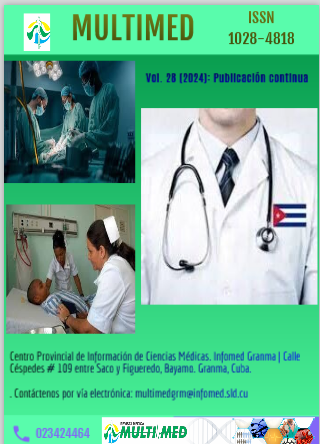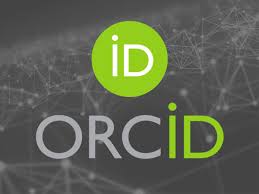Asociación del consumo de frutas y vegetales con marcadores del estrés oxidativo e inflamación en adolescentes cubanos
Palabras clave:
Frecuencia de consumo de alimentos, Consumo de frutas y vegetales, Indicadores de estrés oxidativo, Indicadores de inflamación, Adolescentes.Resumen
Con el objetivo de identificar la relación entre el consumo de frutas y vegetales, los indicadores del estrés oxidativo e inflamación se realizó un estudio transversal con 39 adolescentes. De los indicadores del estrés oxidativo se determinaron en el suero sanguíneo el malondialdehído, los productos avanzados de la oxidación de proteínas y el poder reductor férrico y en eritrocitos el glutatión reducido y como indicador de inflamación el recuento leucocitario y el conteo diferencial. Se encontraron asociaciones significativas a través de los cuartiles del consumo de vegetales y frutas con el potencial reductor férrico y el glutatión reducido con aumento de ambos, así como, con el malondialdehído y los productos de la oxidación avanzada de proteínas, con disminución de estos. Se concluye que el mayor consumo de vegetales y frutas se asoció con variaciones en los biomarcadores de estrés oxidativo, con aumento de los indicadores de las defensas antioxidantes y disminución de los de daño oxidativo inflamatorio.Descargas
Citas
1. Pasupuleti VR, Arigela CS, Gan SH, Salam SKN, Krishnan KT, Rahman NA, et al. A Review on Oxidative Stress, Diabetic Complications, and the Roles of Honey Polyphenols. Oxid Med Cell Longev. 2020; 2020:8878172.
2. Mozzini C, Pagani M. Oxidative Stress in Chronic and Age-Related Diseases. Antioxidants. 2022;11(3):52.
3. Bujtor M, Turner AI, Torres SJ, Esteban-Gonzalo L. Pariante CM, Borsini A. Associations of Dietary Intake on Biological Markers of Inflammation in Children and Adolescents: A Systematic Review. Nutrients. 2021;13(2):356.
4. Zhang C, Ren W, Li M, Wang W, Sun C, Liu L, et al. Association Between the Children's Dietary Inflammatory Index (C-DII) and Markers of Inflammation and Oxidative Stress Among Children and Adolescents: NHANES 2015-2018. Front Nutr. 2022; 9:894966.
5. Andreo-López MC, Contreras-Bolívar V, Muñoz-Torres M, García-Fontana B, García-Fontana C. Influence of the Mediterranean Diet on Healthy Aging. Int J Mol Sci. 2023;24(5):4491.
6. Zhang M, Zhao D, Zhou G, Li C. Dietary Pattern, Gut Microbiota, and Alzheimer's Disease. J Agric Food Chem. 2020;68(46):12800-9.
7. Aleksandrova K, Koelman L, Rodrigues CE. Dietary patterns and biomarkers of oxidative stress and inflammation: A systematic review of observational and intervention studies. Redox Biol. 2021; 42:101869.
8. Papadaki A, Nolen-Doerr E, Mantzoros CS. The Effect of the Mediterranean Diet on Metabolic Health: A Systematic Review and Meta-Analysis of Controlled Trials in Adults. Nutrients. 2020;12(11):3342.
9. Abdul-Aziz S, Gyan Aboagye R, Boadu Frimpong J, Iddrisu H, Ebenezer Agbaglo E, Budu E, et al. Determinants of Fruits and Vegetables Consumption among In-School Adolescents in Ghana. Adolescents. 2021;1(2):199-211.
10. Başıbüyük GÖ, Ayremlou P, Saeidlou SN, Ay F, Dalkıran A, Simzari W, et al. A comparison of the different anthropometric indices for assessing malnutrition among older people in Turkey: a large population-based screening. J Health Popul Nutr. 2021;40(1):13.
11. Malesza IJ, Malesza M, Walkowiak J, Mussin N, Walkowiak D, Aringazina R, et al. High-Fat, Western-Style Diet, Systemic Inflammation, and Gut Microbiota: A Narrative Review. Cells. 2021;10(11):3164.
12. Lakshmi E. Food Consumption Pattern and Body Mass Index of Adolescents − A Descriptive Study. Interl J Nutr, Pharmacol, Neurol Dis. 2021;11(4): 293-7.
13. Tell MN, Hedin K, Nilsson M, Golsäter M, Lingfors H. Associations between intakes of foods and their relations to overweight/obesity in 16-year-old adolescents. J Nutr Sci. 2022;11: e26.
14. Hernández-Triana M, Porrata C, Jiménez S, Rodríguez A, Carrillo O, García A, et al. Dietary reference intakes for the cuban population, 2008. MEDICC Rev. 2009;11(4):9-16.
15. Swann OG, Breslin M, Kilpatrick M, O'Sullivan TA, Mori TA, Beilin LJ, et al. Dietary fibre intake and its association with inflammatory markers in adolescents. Br J Nutr. 2021 ;125(3):329-36.
16. Citrakesumasari C, Kurniati Y, Virani D. Analysis of Nutrition Intake Based on Gender in Adolescents. Open Access Maced J Med Sci. 2020;8(T2):87-9.
17. Song S, Ishdorj A, Dave JM. Gender Differences in Nutritional Quality and Consumption of Lunches Brought from Home to School. Int J Environ Res Public Health. 2021;18(24):13168.
18. Gariballa S, Al-Bluwi GSM, Yasin J. Increased Fruit and Vegetable Consumption Mitigates Oxidative Damage and Associated Inflammatory Response in Obese Subjects Independent of Body Weight Change. Nutrients. 2023;15(7):1638.
19. Madej D, Granda D, Sicinska E, Kaluza J. Influence of Fruit and Vegetable Consumption on Antioxidant Status and Semen Quality: A Cross-Sectional Study in Adult Men. Front Nutr. 2021; 8:753843.
20. Lou A, Wang L, Lai W, Zhu D, Wu W, Wang Z, et al. Advanced oxidation protein products induce inflammatory responses and invasive behaviour in fibroblast-like synoviocytes via the RAGE-NF-κB pathway. Bone Joint Res. 2021;10(4):259-68.
Descargas
Publicado
Cómo citar
Número
Sección
Licencia
Derechos de autor 2024 MULTIMED

Esta obra está bajo una licencia internacional Creative Commons Atribución-NoComercial-CompartirIgual 4.0.
Avisos de derechos de autor propuestos por Creative Commons
1. Política propuesta para revistas que ofrecen acceso abierto
Aquellos autores/as que tengan publicaciones con esta revista, aceptan los términos siguientes:- Los autores/as conservarán sus derechos de autor y garantizarán a la revista el derecho de primera publicación de su obra, el cuál estará simultáneamente sujeto a la Licencia de reconocimiento de Creative Commons que permite a terceros compartir la obra siempre que se indique su autor y su primera publicación esta revista.
- Los autores/as podrán adoptar otros acuerdos de licencia no exclusiva de distribución de la versión de la obra publicada (p. ej.: depositarla en un archivo telemático institucional o publicarla en un volumen monográfico) siempre que se indique la publicación inicial en esta revista.
- Se permite y recomienda a los autores/as difundir su obra a través de Internet (p. ej.: en archivos telemáticos institucionales o en su página web) antes y durante el proceso de envío, lo cual puede producir intercambios interesantes y aumentar las citas de la obra publicada. (Véase El efecto del acceso abierto).








